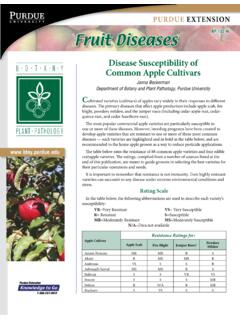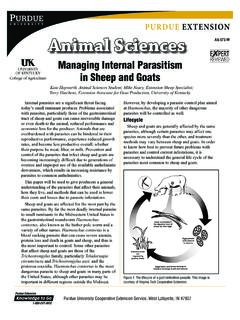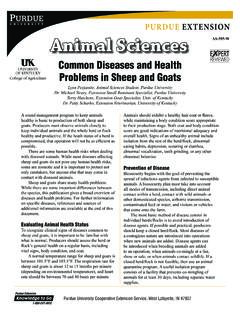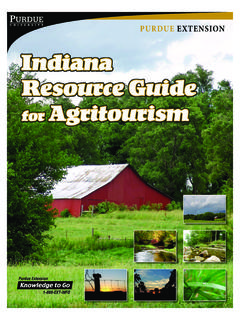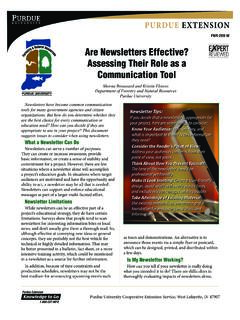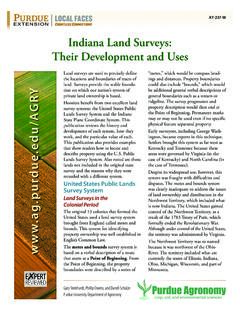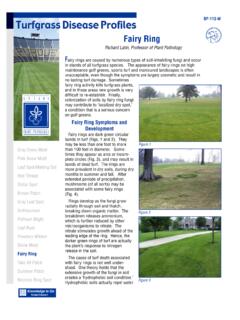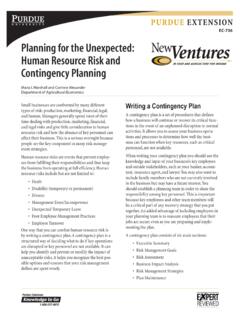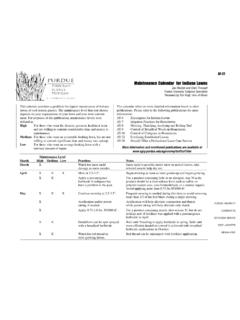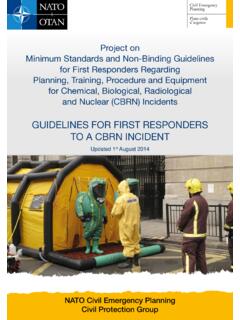Transcription of Construction and Trees: Guidelines for Protection
1 FNR-463-W Purdue extension Construction and Trees: Guidelines for Protection Author Lindsey Purcell, Urban Forestry Specialist, Purdue University Department of Forestry & Natural Resources Trees and machinery can get along. In fact, it is possible to build a new house or install a sidewalk or driveway with little or no damage to surrounding trees. One of the most challenging issues with any Construction project is protecting and preserving existing trees on the site. Established and mature trees on a Construction site can be preserved if provisions are made to ensure the tree trunk, limbs and root system are not damaged or disturbed. During the planning process, it s important to understand that not all trees can be saved, nor should they be. Accurate identification is essential. The decision-making process should include a certified arborist or qualified consultant to determine which trees are sustainable.
2 This will help identify the trees suitable for preservation based on species, size, condition and location. In addition, this preconstruction evaluation provides an opportunity to improve the site by pruning or removing trees that are in decline or dying, or will become a hazard. Depending on the size and species of trees in the Construction zone, trees could be relocated to more appropriate places. Transplanting desirable trees with a tree spade or other mechanical means is possible with assistance from professionals. tree roots usually are considered as out of sight, out of mind. However, this underground system is one of the most vital and easily damaged parts of the plant, making roots the leading cause of decline and death of injured trees. Any encroachment, disturbance or compaction of the soil around the tree can lead to harm, destroying these fine absorbing roots.
3 Injury caused by activities such as improper cutting, Construction and Trees: Guidelines for Protection FNR-463-W tree dripline Protected root zone Dripline of the tree crushing, suffocation or poisoning can result in slow decline, dieback and, eventually, the death of the tree . Trees damaged during Construction projects may take years to exhibit symptoms. The first step in damage prevention is identifying the location of the critical root radius and the protected root zone (PRZ). The dripline area includes the soil and roots that lie directly below the outermost branches. The roots within the dripline are crucial for tree survival. To locate the dripline of the tree , draw a ring just beneath the outermost branches around the entire tree . This is off limits to any project activity. The roots and soil in this area must be protected to ensure tree stability and health.
4 If this area is protected, there likely will not be any major damage to the tree . Not all trees respond the same to changes in their environment. There are degrees to which certain species tolerate Construction activities such as compaction and root cutting. Newly planted or younger trees typically are more resilient in Construction zones. Older, mature trees suffering from decline and those growing in wooded areas are more sensitive to changes in their ecosystem. Additional protective measures should be taken for trees determined to be more sensitive because of species characteristics or age. To determine proper distances for tree Protection consider location, soil type, size and health during the site survey and inventory. Safeguarding sensitive trees that have been growing naturally in a wooded area with a more narrow form, or juvenile trees, can be achieved by using the critical root radius approach.
5 This method provides an increased area of defense and buffers against nearby Construction activity. To determine the critical Protected root zone tree dripline 2 Construction and Trees: Guidelines for Protection FNR-463-W root radius, measure the tree diameter in inches at 4 feet up the trunk, also known as diameter breast height (DBH). Then, multiply that number by to get the distance in feet from the trunk where the protected root zone should be established. For example, if the tree is 16 inches in diameter, multiply times (equals 24 feet) to determine the distance from the trunk where protective fence or barriers should be established around the tree . The area inside this barrier is considered the PRZ. On many sites, especially in urban areas, the critical root zone radius and even the protected root zone area cannot be achieved because of limited space.
6 Preservation of the soil volume supporting the tree is equally as important as minimizing disturbances. Do not allow more than 25 percent of the roots in the PRZ to be damaged. Don t give up on saving a tree if the recommended allowances cannot be met and disturbances occur. Trees may overcome Construction damage to an extent if preconstruction and post- Construction measures are taken. A healthy tree always has a better chance to overcome damage. For a Construction project that involves successfully preserved trees, work begins in the planning and Construction phases. Good communication between the property owner, arborist, project manager and contractor is vital to saving trees. The list below gives some minimum standards for building sites where vegetation is to be preserved. These Guidelines should be incorporated into Construction documents and posted on site, and the details made available to all involved who work on the site, especially equipment operators.
7 tree preservation is site-specific and other Guidelines and protective measures also may be appropriate. 1. Protection barriers: Install a physical and highly visible obstruction around the tree or trees to be preserved. Use durable fencing material, such as plastic Construction fencing, snow fence or chain link. Place the barrier as determined in the preconstruction survey, identifying the critical root zone (CRZ) and protected root zone (PRZ). 2. signage : Place tree Protection signs in Protection areas and in visible places. All signage should be in both English and Spanish. Place signs approximately every 20 feet on Protection fences. 3. site access: Identify and prepare access areas for all Construction activities. Limit vehicular traffic to designated paths, which minimizes loads on site soils.
8 Limit crew and project parking to locations off site. Prepare and maintain the access ways with at least 6 inches of hardwood mulch to reduce compaction. 4. storage of materials: Do not allow storage of chemicals, materials or supplies within the area of the protective barriers. 5. Fuel storage: Do not allow fuel storage on the site, and specify this in the preservation plan. Petroleum-based products can contaminate the soil and are highly toxic to trees. Require refueling, servicing and maintenance of equipment and machinery in an off-site area. 6. debris and waste materials: Do not allow debris and waste from Construction activities within protected areas. Washing down concrete or cement handling equipment, in particular, should be prohibited on site. The ingredients in concrete products are high in pH, which is very caustic and can drastically alter the soil chemistry, damaging plants.
9 7. Grade changes: Have an International Society of Arboriculture Certified Arborist or other qualified experts approve any grade changes before Construction begins, and specify measures to reduce serious Construction activities. Grade changes can be damaging to trees, with as little as 2 inches of fill soil over the root zone of a tree potentially causing death. Removing soil or lowering the grade can destroy major portions of a root system, causing decline and eventual death. 3 Purdue AGriculture It is the policy of the Purdue University Cooperative Extension Service that all persons have equal opportunity and access to its educational programs, services, activities, and facilities without regard to race, religion, color, sex, age, national origin or ancestry, marital status, parental status, sexual orientation, disability or status as a veteran.
10 Purdue University is an Affirmative Action institution. This material may be available in alternative formats. Order or download materials from Purdue Extension The Education Store 4 03/12 Construction and Trees: Guidelines for Protection FNR-463-W 8. root cutting and pruning: If it becomes necessary to precut or prune roots outside the PRZ during Construction , require clean cuts perpendicular to the natural growth direction. Also, backfill within an hour of cutting roots and water the tree within 24 hours. Severing roots can have a significant impact on tree health and survival, as well as tree stability. 9. Physical damage: Have an ISA Certified Arborist perform any advance pruning that will reduce physical damage to low limbs, etcetera, especially considering the clearances required by equipment.
